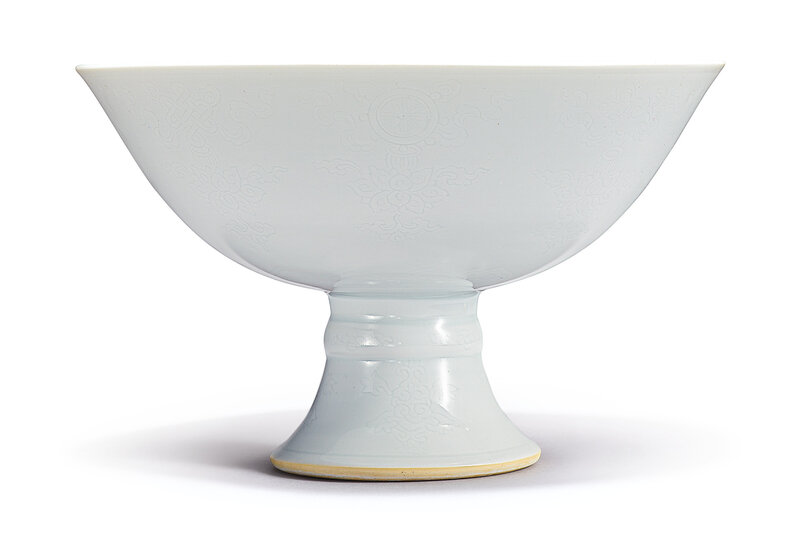A fine anhua-decorated white-glazed 'Eight Buddhist emblems' stemcup, Yongzheng mark and period (1723-1735)
Lot 631. A fine anhua-decorated white-glazed 'Eight Buddhist emblems' stemcup, Yongzheng mark and period (1723-1735). Diameter 7 in., 17.8 cm. Estimate 50,000 — 70,000 USD. Lot Sold 87,500 USD. © Sotheby's.
the rounded flared sides resting on a splayed pedestal foot, the exterior of the bowl finely incised with beribboned 'Eight Buddhist Emblems' each supported on stylized lotus blooms, above a band of ruyi heads, the stem with further lotus sprays and encircled by a raised filet incised with a band of florets, all under a lustrous white glaze pooling to a bluish tint in the recesses, the interior of the stem inscribed with a horizontal six-character mark in underglaze blue.
Provenance: Christie's New York, 29th March 2006, lot 460.
Literature: Karen Thomson, ed., The Blema and H. Arnold Steinberg Collection, Montreal, 2015, pl. 157
Note: Notable for its pristine white glaze, refined form and delicate anhua or ‘hidden decoration’, this elegant stemcup derives its design from prototypes made in the early Ming dynasty. The Yongzheng Emperor revered and studied these wares and a monochrome white stembowl was included in the handscroll Guwantu [Pictures of antiquities] from 1729, in the Victoria and Albert Museum, London, which depicts treasured objects in the Imperial collection (China. The Three Emperors. 1662-1795, Royal Academy of Arts, London, 2005, cat. no. 169, p. 255 bottom right). According to the Qing Imperial archives, the Yongzheng Emperor was actively involved in their production, in 1732 issuing a decree to “Make some stemcups in each of these colours: sacrificial red, sacrificial blue, yellow and white. Also have some heavier pieces ready for bestowal on Mongolian nobles as occasions arise” (The Tsui Museum of Art. Chinese Ceramics IV. Qing Dynasty, Hong Kong, 1995, p. 45).
A closely related stemcup was included in the exhibition Ch’ing Porcelain from the Wah Kwong Collection, Hong Kong, 1974, cat. no. 51; another was sold at Christie’s Hong Kong, 29th October 2010, lot 2821; and a third was sold in these rooms, 17th-18th March 2015, lot 281. Stemcups of this type are also known covered in other monochrome glazes; a Yongzheng mark and period stemcup, similarly carved with the 'Eight Buddhist Emblems' but covered in a yellow glaze, in the Baur Foundation, Geneva was included in the exhibition A Millennium of Monochromes. From the Great Tang to the High Qing. The Baur and the Zhuyuetang Collections, Geneva, 2018, cat. no. 183; another from the Sir Percival David collection, now in the British Museum, London, was published in Margaret Medley, Illustrated Catalogue of Ming and Qing Monochrome Wares in the Percival David Foundation of Chinese Art, London, 1989, pl. A575; and a slightly larger example with green glaze was included in the Oriental Ceramic Society exhibition, The Ceramic Art of China, London, 1971, cat. no. 248. See also similar white-glazed examples, but without the central node, illustrated in Chinese Porcelain: The S. C. Ko Tianminlou Collection, Part I, Hong Kong, 1987, pl. 134 and Shimmering Colours: Monochromes of the Yuan to Qing Periods, The Zhuyuetang Collection, Hong Kong, 2005, pl. 23.
Sotheby's. Important Chinese Art, New York, 10 september 2019

/https%3A%2F%2Fprofilepics.canalblog.com%2Fprofilepics%2F1%2F0%2F100183.jpg)
/https%3A%2F%2Fstorage.canalblog.com%2F03%2F02%2F119589%2F96711876_o.jpg)
/https%3A%2F%2Fstorage.canalblog.com%2F11%2F31%2F119589%2F94773502_o.jpg)
/https%3A%2F%2Fstorage.canalblog.com%2F20%2F83%2F119589%2F94772815_o.jpg)
/https%3A%2F%2Fstorage.canalblog.com%2F26%2F72%2F119589%2F75604929_o.jpg)
/https%3A%2F%2Fstorage.canalblog.com%2F59%2F60%2F119589%2F26458628_o.jpg)




/http%3A%2F%2Fstorage.canalblog.com%2F63%2F56%2F119589%2F129161156_o.jpg)
/http%3A%2F%2Fstorage.canalblog.com%2F22%2F31%2F119589%2F129007587_o.jpg)
/http%3A%2F%2Fstorage.canalblog.com%2F61%2F51%2F119589%2F128994063_o.jpg)
/http%3A%2F%2Fstorage.canalblog.com%2F55%2F46%2F119589%2F128987916_o.jpg)